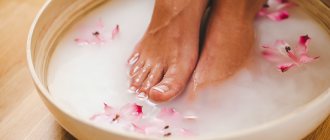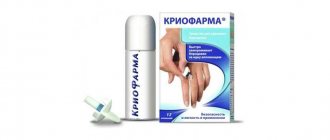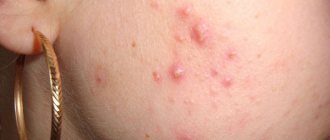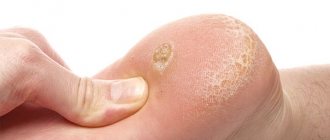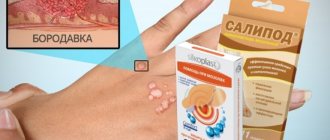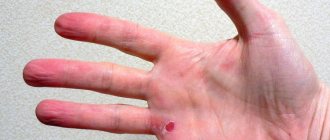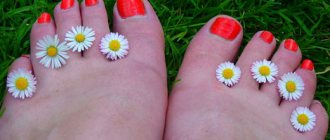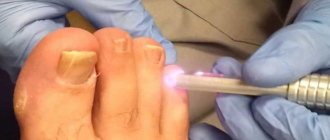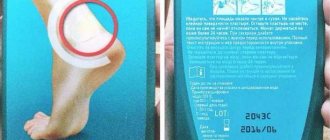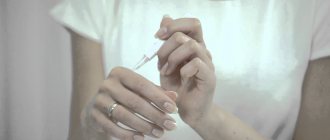A callus with clearly visible black dots in the middle is actually a wart - the result of a viral infection in a person. Black or dark red dots inside the formation are clogged capillaries. The growth appears more often on the hard skin of the feet or hands. The wart rises above the skin surface by 1-2 mm. It has a clearly defined rim, the middle is filled with thin spines, reminiscent of ripe cauliflower. Due to its unique appearance, it is popularly called “chicken butt” or spiny.
Chicken wart is a benign formation, but if it is constantly wounded, it is capable of malignant degeneration. At the beginning of its development, the growth resembles a small pimple, which practically does not cause any particular inconvenience. As the wart grows, it forms a powerful root system that goes deep into the subcutaneous layer. When pressing on the spine while walking, the roots irritate the surrounding tissues, causing significant pain.
What is a callus?
A callus is a thickening on any part of the human body. It is caused by the regular process of friction of the skin with any object. It often appears on the feet due to improperly selected shoes, hosiery, or due to the special structure of one or both feet.
Callus has two main types.
Depending on the structure, it can be skin or bone.
- The first type is the most common and appears to be a thickened part of the skin. The reason for the appearance is the body’s reaction to close contact with the surface of something.
- Callus differs in its structure. It can appear after a fracture in the form of a new growth from bone tissue.
How to treat ingrown calluses?
The main thing you should know is no self-medication! Such formations are strictly not allowed to be cauterized, cut out, steamed, or treated with caustic compounds or “magic” ointments. All methods not recommended by the doctor often lead to skin damage, which will lead to the dynamic growth of deep calluses. First a dermatologist, then treatment. Only a doctor can determine the dynamics of the course and development of the pathology, the depth of germination of the rod. Depending on these factors, treatment will be determined and medicinal, surgical or traditional methods of treatment will be prescribed.
Important! A viral fungal infection, which is typical in the presence of a black callus with a dot, can quickly spread to healthy areas of the skin if self-medicated. Curing the disease will become much more difficult.
Types of calluses and treatment methods
Gvozdevaya
A rare type of callus.
Does not have a hole or black spot in the middle.
Outwardly it resembles a nail, the head of which is on top.
It has a small round shape.
Rod
A distinctive feature of this callus is its structure.
The surface of the skin acquires a slight compaction, and under it there is a base.
The main inconvenience is severe pain due to the root located in the tissues.
Such a deep callus can be removed by contacting a medical center for hardware or surgical intervention.
There are several ways to get rid of a callus, for example drilling.
Cryotherapy, as a result of which the callus is frozen, and it dies off on its own.
Laser action that evaporates the liquid contained in the callus, which leads to drying of the rod and the formation itself.
Water
A similar callus can be observed when wearing uncomfortable shoes.
A blister appears that is filled with blood or lymph fluid. The outer skin is thin and easily torn from external influences.
A watery callus should not be pierced or picked off on its own. The treatment procedure is aimed at eliminating mechanical effects at the site of injury.
As a result, the neoplasm will heal on its own, and the contained lymphatic fluid will dissolve and help restore the skin.
Dry
Occurs in various parts of the body. It is a small keratinized part of the skin. It feels hard and unpleasant to the touch.
Treatment should be carried out even in the absence of painful symptoms.
To do this, steam your feet in warm water with various additives such as soda, soap, potassium permanganate or tea tree oil.
Corns
This callus is similar to the one described above.
However, it only appears on the soles of the feet.
It has no definite boundary and varies in size.
The cause of the appearance is general dry skin, frequent walking and wearing hard shoes.
Cone
It appears as thickenings on the big toes. Sometimes it causes discomfort when walking.
The cause may be heredity.
Development occurs for no apparent reason.
Bumps also occur when wearing uncomfortable shoes for a long time.
If the callus is exposed to regular mechanical stress, it can turn into a bunion. This type of callus occurs on the big toes near the joints and contains fluid inside.
The result is severe pain when walking.
Treatment for a bump or bunion should begin by changing your shoes to more comfortable ones. If the callus does not cause pain and does not grow, then there is no reason to worry. But when it becomes a hindrance, you should visit a surgeon.
Outdated
Without timely action, the rubbed parts of the skin turn from new calluses into old ones, the skin on which is keratinized. Such formations are most uncomfortable on the toes. The treatment is long and difficult. Modern pharmacology provides many means to get rid of rough skin. Their action is based on softening and then removing the growth.
The most well-known method for removing calluses on the feet is cutting. To do this, you need the following: a bath with hot water, soap and soda.
- Keep your feet in it for 15 minutes.
- As a result, the old skin will become softer and the top layer can be removed.
- Then apply a patch or lubricate the area with salicylic acid.
The procedure is carried out carefully. The drug should be kept away from healthy skin to avoid damage.
Root
Black or black-spotted callus. This formation indicates the location of the root under the skin. The blackhead has a round, keratinized surface. The cause may be fungal diseases or unsuitable shoes. When a black dot is clearly visible on the callus, you should turn to laser treatment or cryotherapy.
Soft callus
In this case, the soft formation could have originally been a water callus that was damaged. It looks like a small wound with peeling skin. It needs to be given serious attention, since the damaged area of the skin can easily become infected.
If such a formation is detected, immediately disinfect and do not tear off the skin, as it serves as protection against microorganisms. After disinfection, cover the injury site with a bandage.
Treatment is carried out using the following method:
- cessation of any mechanical impacts on the affected skin.
- To treat, wipe the skin with an antiseptic.
- Cover the area with a plaster or bandage.
It is necessary to remove and treat soft callus under sterile conditions to ensure protection from infection and further suppuration.
White
It is a small blister with intact skin on top. There is lymph inside. The cause is excessive wearing of uncomfortable shoes.
To speed up treatment, you should change your shoes. You can release the accumulated fluid from the bubble using a disinfected needle. Then the callus is disinfected, an anti-inflammatory ointment is applied and the area is bandaged.
Red
Same as described above.
The only difference is in the component of the blister, which is filled with blood from the damaged vessel.
Treatment methods are similar.
Purulent
Occurs as a result of improper treatment of white and red calluses. If the wound is not disinfected in time, the injured part of the skin will fester under the influence of bacteria.
To get rid of this, you will have to carry out urgent disinfection using antibacterial drugs.
The injured area should be covered with bandages or adhesive tape. Among the folk remedies, you can use aloe juice to cleanse pus and a potato-tomato mixture for compresses.
How to get rid of calluses with blackheads on feet
The only reason for the appearance of formation is infection with papillomavirus, which can occur:
- from mother to child as the baby passes through the birth canal;
- in swimming pools, bathhouses and other public places through poorly disinfected shoes. Therefore, it is recommended to have your own replacement;
- through impaired skin integrity upon contact with a virus carrier.
The virus enters the human body and may not manifest itself for years. Under certain circumstances, HPV is activated and one or more warts appear on the body.
Provokes the “awakening” of papillomavirus:
- loss of immunity, weakening of vitality as a result of acute or chronic diseases;
- fungal infection accompanied by excessive sweat production;
- deformation of the bones of the foot due to flat feet, contributing to pressure and friction of areas of the sole;
- preference for high heels, tight shoes made of synthetic materials;
- hormonal imbalance caused by pregnancy, adolescence, menopause, diseases;
- endocrine diseases, such as diabetes;
- curvature of the toes due to arthritis, leading to their compression.
What is a callus?
This formation is located in the upper layer of the skin - the epidermis. This layer is a "brick wall" with a wide layer of cement-like substance on top and a "roof" on top. “Bricks” are living skin cells, they are born in the lower row and rise over time, replaced by newborn epithelial cells.
As it rises, the nucleus and organelles are lost, the “brick” turns into the cement-like substance eleidin, and then becomes the dead scale of the uppermost layer. This process is called “keratinization.”
It is also called keratinization due to the presence of keratin protein in the last layer - the main substance that first encounters mechanical irritants, chemical elements and microbes, preventing them from entering the lower layers of the skin.
Normally, the cells of the lower layer reach the top in 28-72 days. After this, they fall off, and along with them go particles of dirt and those substances that the body removes through sweat (ammonia, some medications and salts).
But if a certain area of the skin is constantly exposed to pressure, if it constantly rubs against clothing, or if a special type of virus has settled in it, preventing dead cells from exfoliating in time, dry callus (hyperkeratosis) appears.
If the processes of keratinization are rearranged so that under a large layer of unexfoliated cells a cone of cartilage-like density appears, which with its apex is directed into the deep skin layers, a callus with a core appears. At the same time, the core compresses the blood vessels of the skin, impairing its nutrition and promoting even greater growth of the cone.
It will not be possible to remove such a skin defect by simply removing the layer of dead cells; you need to get rid of the core.
Structure of the callus
Reasons for formation
As already mentioned, most often hyperkeratosis develops on the legs - in those places that are most susceptible to friction. Callus occurs due to:
- wearing uncomfortable (narrow, flat-soled, non-breathable, constrictive or too loose) shoes;
- transferring the entire body weight to the toes, which happens when putting on high-heeled shoes;
- frequent walking barefoot;
- entry of a foreign body (wood chips, metal shavings, grains of sand, piece of glass) into the skin, which the skin tissue tries to delimit from healthy areas;
- infection with a dermatotropic (one whose effect is manifested in the skin) virus. Most often it is the human papillomavirus;
- fungal infection of fingers and nails.
Calluses on the hands appear when:
- frequent or prolonged use of a knife;
- writing for a long time with a pen that the person is holding incorrectly;
- frequent work with garden tools;
- playing sports: hanging on horizontal bars, exercising on rings or uneven bars;
- foreign body entry;
- contact with warts, papillomas, resulting in infection with the papillomatous virus;
- fungal infections of the skin of the hands.
The chance of developing calluses with a core is increased by non-compliance with safety precautions, when manual work is done without gloves, wearing wide socks or loose insoles that can wrinkle inside the shoes. The risk group also includes people with impaired blood circulation in the extremities, suffering from diabetes or having problems with the immune system.
Callus most often appears as a result of wet callus, the so-called “dropsy”.
Symptoms of the disease
You can think about the fact that a person has developed hyperkeratosis with a rod in the case when placing the leg in some position becomes uncomfortable and painful. In this case, the pain is not sharp, piercing, as in the case of a splinter, but dull.
What does a callus look like?
This is an area of light skin, with the same skin pattern as the surrounding skin. It has a heterogeneous structure, a shape close to round, and a “pit” in the center.
Upon closer examination, the formation resembles a plug inserted into the skin; when pressed it is painful and can cause gait disturbance.
Unlike warts, it does not bleed even with strong pressure and does not form in one location in the plural.
Favorite localizations:
- on the heels;
- on the toe: mainly on the little finger on the outside, as well as between the 1st and 2nd fingers, 4th and 5th fingers on the inside;
- on the palms;
- on the fingers.
Diagnostics
Treatment of callus begins after a dermatologist has established an accurate diagnosis, differentiating the disease with a plantar wart or a malignant formation. The diagnosis is usually made by the appearance of the skin defect.
At the same time, a blood test is carried out to determine the level of glucose, glycosylated hemoglobin (if diabetes mellitus is not diagnosed), antibodies to the human immunodeficiency virus and papillomatosis.
These studies, provided that subsequent treatment for such conditions is prescribed, make it possible to more effectively combat core calluses.
Removal of hyperkeratoses with a rod by a specialist
To quickly and painlessly get rid of calluses, even if they are old, professionals use one of three hardware types of treatment. It is carried out in cosmetology offices and dermatology clinics, as well as in a podiatrist’s office.
Hardware pedicure
This is a method in which, under visual control, the area of hyperkeratosis is “drilled out”. The skin of the foot or hand does not require preliminary softening in the bath, and no other preparation is needed.
Why does a growth form on the legs?
The only reason for the appearance of formation is infection with papillomavirus, which can occur:
- from mother to child as the baby passes through the birth canal;
- in swimming pools, bathhouses and other public places through poorly disinfected shoes. Therefore, it is recommended to have your own replacement;
- through impaired skin integrity upon contact with a virus carrier.
The virus enters the human body and may not manifest itself for years. Under certain circumstances, HPV is activated and one or more warts appear on the body.
Provokes the “awakening” of papillomavirus:
- loss of immunity, weakening of vitality as a result of acute or chronic diseases;
- fungal infection accompanied by excessive sweat production;
- deformation of the bones of the foot due to flat feet, contributing to pressure and friction of areas of the sole;
- preference for high heels, tight shoes made of synthetic materials;
- hormonal imbalance caused by pregnancy, adolescence, menopause, diseases;
- endocrine diseases, such as diabetes;
- curvature of the toes due to arthritis, leading to their compression.
Preventive actions
Prevention of the disease helps prevent the occurrence of warts on the sole in the future:
- You should constantly support your immunity, which suffers from lack of sleep, stressful situations, poor nutrition, and lack of vitamins;
- monitor compliance with personal hygiene rules, try not to touch staircase railings or handrails in passenger transport with bare hands, be sure to wash your hands with soap after visiting public places;
- It is recommended to promptly treat wounds and scratches with antiseptic agents;
- try not to touch the hands and common objects of a person who clearly shows signs of papillomavirus disease;
- It is recommended to come to the bathhouse or swimming pool with your own change of shoes;
- protect against damage to the skin of your hands when using chemical cleaning products by wearing rubber gloves;
- do not wear shoes made of synthetic materials;
- It is advisable to have one permanent partner for an intimate relationship.
If you discover a growth, you should immediately consult a dermatologist. This is especially true for the treatment of pregnant women, nursing mothers and children under 16 years of age. The doctor will diagnose the formation and make an appropriate prescription to get rid of the problem forever.
There is only one treatment for warts - timely removal of the formation using traditional, medicinal or surgical methods.
Each person independently chooses ways to defeat a viral disease. Despite the numerous recipes for traditional treatment, it is safer and faster to remove the formation in a medical facility using sterile instruments. Only persistence and adherence to strict hygiene rules helps to get rid of calluses with blackheads forever.
Which doctor should I contact for help?
- The main specialist is a dermatologist. However, depending on the nature of the disease, there may be other options.
- In the case of callus, you should seek help from a surgeon. It will also help with purulent, infected and severe calluses.
- In other situations, aesthetic medicine specialists can come to the rescue. Using cryotherapy, laser or hardware drilling, the defect can be removed.
In particularly advanced situations, the intervention of a surgeon and an operation may be required, which will affect the entire life activity of a person and limit the usual physical activity. In addition to laser and surgery, conventional ointments can be used in treatment. But often a person notices the presence of a problem already in an advanced state, which requires a serious approach to recovery.
To effectively combat calluses, their prevention is necessary. In areas most susceptible to mechanical stress, it is worth applying cream in the evenings or gluing a patch when wearing uncomfortable shoes. Socks and shoes on your feet must match in size and be made from natural fabrics and materials.
Core (ingrowing, deep) callus is a dense keratinized growth on the sole, toes, and less often on the palms. At first glance, the formation is practically no different from ordinary calluses. But the rod variety with a black dot in the central part of the formation causes much more inconvenience.
In the area of the compacted, hardened growth, severe pain is felt when walking. Calluses on the toes get in the way, rub, and prevent you from wearing fashionable shoes. The sooner you recognize an insidious formation and consult a doctor, the greater the chances of recovery.
And a little about the author’s secrets
Have you ever experienced unbearable joint pain? And you know firsthand what it is:
- inability to move easily and comfortably;
- discomfort when going up and down stairs;
- unpleasant crunching, clicking not of your own accord;
- pain during or after exercise;
- inflammation in the joints and swelling;
- causeless and sometimes unbearable aching pain in the joints.
Now answer the question: are you satisfied with this? Can such pain be tolerated? How much money have you already wasted on ineffective treatment? That's right - it's time to end this! Do you agree? That is why we decided to publish an exclusive interview with Oleg Gazmanov, in which he revealed the secrets of getting rid of joint pain, arthritis and arthrosis.
Source of the article: https://mozolinet.ru/sterzhnevaya-mozol/pochemu-u-detej-poyavlyaetsya-sterzhnevaya-mozol-i-chem-ee-mozhno-vylechit.html
Causes
Deep callus appears under the influence of various factors. Main reasons:
- constant mechanical impact (friction, pressure) on the skin. Tight, uncomfortable shoes, wrinkled, torn insoles, socks that don’t fit and rub and put pressure on the soles. The result is calluses on the toes;
- damage to the skin by a foreign body, for example, a grain of sand, a splinter. Inattention to a foreign object under the skin leads to its ingrowth into the stratum corneum. Gradually a growth forms around the foreign body, pain is felt in this area;
- walking barefoot for a long time. Often, deep calluses appear in residents of rural areas, children running barefoot during their summer holidays in the village;
- wearing shoes made of low-quality materials. The feet do not breathe, sweat, slip, and friction increases. A wrinkled insole increases the negative impact on the skin;
- Growths on the feet are caused by two factors that are radically different from each other - high heels and flat soles. In both the first and second cases, corns and calluses often form;
- Seals appear on the palms and fingers when constantly working with tools. If left untreated, an ordinary callus will degenerate into a dry variety. After a while, under the influence of a fungus, when the skin is injured, a rod grows deep into the tissue;
- fungal or viral infection. Growths caused by exposure to pathogenic flora are difficult to treat, especially in advanced cases with deep ingrowth of the core. Fungi often form calluses on the hands.
Locations:
- soles (convex part of the foot);
- interdigital spaces between the first and second, fourth toe and little toe;
- sometimes - in the center of the heel;
- less often on fingers, palms.
Causes of appearance on the skin
Rod formation in small children can appear for several reasons, including:
- Wearing narrow, uncomfortable shoes for a long time. If shoes, ballet flats or sneakers rub against a child, sooner or later a callus will appear. So you should always keep an eye on this factor when buying shoes that are the right size for your baby or even a little larger so that they don’t need to be worn in.
- The appearance of a foreign body in the skin. For example, if a baby picks up a splinter, but the adults do not notice it, then after a while it can grow in and transform into a calloused formation. In this case, the pain will be quite strong, aching, and causing great discomfort with any movement. To avoid this, you should always examine your baby after a walk and listen to his complaints.
- Walking for a long time without shoes. Bare feet are constantly subject to mechanical friction, which is why walking barefoot often causes growths to occur. In villages and dachas, it is best not to let your child walk without flip-flops or ballet shoes for a long time.
- Increased sweating. Children are less likely than adults, but still encounter this scourge. It may appear as a result of any disease (for example, a common cold) or due to wearing low-quality shoes. Both reasons are quite common, although they are not so difficult to deal with. In the first case, the child should be protected from walking, in the second, simply replace old shoes with new ones, preferably made from natural, breathable materials.
- Constantly wearing ballet shoes. This factor is most relevant for girls, although it includes all flat-soled shoes, except sneakers. It is better to buy orthopedic models, although they are more expensive, they will last longer and protect the children’s feet from various troubles, such as growths.
How to get rid of heel spurs?
Readers constantly write letters to us with questions: “How to deal with foot fungus? What to do about unpleasant foot odor? and other pressing questions from our readers.” Our answer is simple, there are many folk remedies. But there is also a more effective remedy for fungus ARGO DERM, which doctors have now developed. Actually, A. Myasnikov gave an interview regarding this product, we advise you to read it.
These are the most common reasons for the formation of calluses on the skin among children. They are quite easy to deal with, even in the ways described above. So the easiest way is to initially prevent the possibility of such an unpleasant phenomenon as a callus with a core, especially in children.
Medications
Pharmaceutical preparations based on salicylic acid will help get rid of painful growths. Apply the composition only to damaged areas: the potent product irritates healthy skin.
For the treatment of calluses on the feet, the following are effective:
- ointment "Super Antimozolin". Active components – urea, lactic acid;
- Vitaon or Karavaev balm. The drug contains herbal extracts and copes well even with deep formations;
- cream "Nemosol". A proven product containing salicylic acid;
- liquid "Stop callus". With regular use, good results are noticeable. Another advantage is convenient packaging;
- If fungi or viruses are detected, the dermatologist will prescribe modern antiviral and antifungal compounds - Acyclovir, Penciclovir, Lamisil.
Find out interesting details about ultrasonic facial cleansing at home.
Read all about treating psoriasis on the body with folk remedies on this page.
Corn plaster
The Salipod callus patch was created specifically to combat ingrown calluses An effective, easy-to-use remedy will relieve painful formations in a short time.
Of course, there are exceptions, sometimes the patch does not help. Most likely, a fungal or viral infection is to blame in this case. You can’t do without special creams and ointments.
- wash your feet, dry them;
- Apply “Salipod” to the affected skin and secure it with an adhesive plaster on top;
- keep the patch on the callus for 3 days;
- after the expiration date, remove “Salipod”;
- steam your feet, remove the rod;
- if the core is deeply ingrown, repeat the procedure;
- usually the rod comes out, leaving a hole;
- treat this area with iodine and cover it with an adhesive plaster.
What does official medicine offer?
The doctor examines the plantar formation of a patient who comes to him. An analysis is prescribed to determine which particular papillomavirus the infection occurred. If the wart is small, up to 1 cm in diameter, conservative treatment can be used:
- lubricating the surface with caustic substances based on the action of various acids or alkalis, which contribute to burning out the body of the growth and its roots. Special creams, gels, ointments, and patches are used. If treatment is done on your own, you must act exactly according to the instructions to avoid burns to surrounding healthy tissue;
- External and internal medications are prescribed to help quickly restore immunity so that the body can produce substances that counteract viral infection;
- antiviral treatment is carried out.
Complex measures are effective if the disease is not advanced.
Modern removal methods
Consult a dermatologist about removing growths on the soles of your feet and toes. There are effective, painless methods that allow you to get rid of even overgrown formations. A beauty salon or beauty clinic will offer you several effective methods.
Professional methods for removing callus:
- laser removal. The method is effective in advanced cases. The laser beam is capable of burning the rod to the ground. Another advantage is that during the procedure, pathogenic bacteria that have penetrated the affected area are destroyed. For this reason, the risk of developing an inflammatory process after the procedure is reduced to zero;
- hardware callus removal. The doctor uses a special device to “drill out” the formation. It is important to completely get rid of the rod. After the procedure, an antifungal or antibacterial agent is placed in the canal. A correctly performed procedure usually does not cause complications. The risk of relapse is minimal;
- cryodestruction. Removing growths using liquid nitrogen is one of the proven methods. Low temperatures “burn out” the painful lump along with the central part. Less than a minute - and the tissues are destroyed. With complete removal, re-germination is virtually impossible.
Core calluses in children
Dense painful growths often appear in children after summer holidays spent in the village with their grandmother. More often, boys suffer from unpleasant manifestations due to the specifics and nature of the games, less attention to appearance, the quality of shoes, and foot hygiene. Running barefoot on the grass or country road injures delicate skin.
Children often exchange sandals and shoes. A fungal infection penetrates the stratum corneum.
- tight, low-quality shoes that “do not breathe”;
- uncomfortable, sliding insoles;
- crumpled socks that are the wrong size;
- old wounds, splinters, around which a keratinized area has appeared;
- viral, fungal infections.
What to do? Be sure to consult a dermatologist. The doctor will check whether the child has corns or calluses. In the early stages, age-appropriate folk remedies will help. Often the doctor recommends ointments and callus fluids. The choice of product also depends on the age of the child.
For deep rods, the most gentle and effective procedure for children is laser destruction. The low-pain method is used in most cosmetology clinics.
- no pain;
- high-quality removal of formation and core;
- minimal recovery period;
- low probability of relapse.
How to treat?
Skin growths of this type can be treated without problems only in the initial stages after their formation. Here you can use medications and even turn to traditional medicine, but it is advisable to first consult a doctor, since the child’s body may react negatively to some medications.
If you take traditional methods of treating calluses, then you should pay attention to the following:
- Hot soapy baths. You will need to spend from 30 minutes to an hour in the water, all this time you need to maintain a fairly high temperature. After this, the baby’s feet or hands are treated with pumice (it is best to take a softer model). This procedure will be effective for new growths that have recently formed on the skin.
- Salicylic ointment. For babies, it is best to use a 5% product so as not to injure delicate skin. Apply the ointment to the skin once a day, before bed, directly on the callus itself. After some time, it will begin to dissolve on the skin. If this does not happen, you need to take a break for several days and try applying the product after a hot bath.
- Celandine. This plant helps get rid of skin problems due to its drying effect. In addition, it disinfects and kills all harmful bacteria that may be on the baby’s injured skin. To make a compress, you need to pass fresh celandine through a meat grinder, and then apply directly to the growth. Cover the resulting mass with any clean rag and put on a sock (or glove).
In the same way, you can make a compress from aloe, which will give a similar effect. In principle, these three methods will be quite sufficient to treat calluses in the initial stages.
Important! Children under 3 years of age are not recommended to apply salicylic ointment without first consulting a doctor.
Preventive recommendations
Preventing the appearance of deep calluses is simple:
- choose shoes made of genuine leather;
- change wrinkled or torn insoles in a timely manner;
- do not walk for a long time in shoes with thin soles or, conversely, high heels;
- take care of your feet, don’t forget about pumice and nourishing foot creams;
- for severe sweating, take baths with chamomile, oak bark, sprinkle your feet with talcum powder or baby powder;
- Don't wear other people's shoes.
Below is a video in which you can clearly see the process of removing calluses using a modern hardware method:
Did you like the article? Subscribe to site updates via RSS, or follow updates on VKontakte, Odnoklassniki, Facebook, Google Plus or Twitter.
Subscribe to updates by E-Mail:
Tell your friends!
Why does a growth form on the legs?
The only reason for the appearance of formation is infection with papillomavirus, which can occur:
- from mother to child as the baby passes through the birth canal;
- in swimming pools, bathhouses and other public places through poorly disinfected shoes. Therefore, it is recommended to have your own replacement;
- through impaired skin integrity upon contact with a virus carrier.
The virus enters the human body and may not manifest itself for years. Under certain circumstances, HPV is activated and one or more warts appear on the body.
Provokes the “awakening” of papillomavirus:
- loss of immunity, weakening of vitality as a result of acute or chronic diseases;
- fungal infection accompanied by excessive sweat production;
- deformation of the bones of the foot due to flat feet, contributing to pressure and friction of areas of the sole;
- preference for high heels, tight shoes made of synthetic materials;
- hormonal imbalance caused by pregnancy, adolescence, menopause, diseases;
- endocrine diseases, such as diabetes;
- curvature of the toes due to arthritis, leading to their compression.
Classification of seals on the foot
If a lump appears on the foot that causes pain, it should be classified in order to prescribe adequate therapy. The characteristic shape of the seal resembles a ball, the dimensions of which range from 1-2 mm to 3-4 cm. When you press on the seal, a sharp pain occurs.
The most common factors when a lump appears on the foot and hurts may be the following conditions:
Corns
With keratinization of the skin on the feet, which is caused by improperly selected shoes, obesity, excessive sweating, flat feet, arthritis, etc. This reason is the most common. Corns can be flat, dry, raised, with or without rods. They have a yellowish-brown tint, a rough skin surface with reduced sensitivity to external influences.
In some cases, cracking of the foot is possible, accompanied by pain during increased physical activity. In the absence of timely treatment, the foot may become deformed, displaced, and the ball of the big toe may become enlarged.
Corn
A distinctive feature of calluses is their shape, which is a round, limited area of skin on the heel or toes, which is accompanied by pain even with slight pressure. Often, calluses can appear in a child, which is associated with the wrong choice of shoes, flat feet and injuries.
Calluses can be wet or dry. Wet calluses are the most dangerous, since they contain an accumulation of fluid (blood, serous exudate), which can leak out when the callus is traumatically damaged. As a result, there is a possibility of infection of the wound surface. In addition, wet calluses can transform into dry calluses, but with deeper roots.
What is the danger of a callus on the thumb?
When calluses form, nothing destroys a person’s life, but there is a high risk of infection if the callus is in the form of dropsy.
As a result of damage to the bladder, a wound is formed and, if measures are not taken to prevent the penetration of pathogenic microflora into it, infection can occur.
The formation of growths often prevents a person from walking normally.
When the foot is compressed by shoes, pain appears.
The presence of corns and fresh calluses provoke a burning sensation and pain when walking.
Treatment of such growths should begin immediately after they appear.
Treatment options
If a lump appears on the foot and it hurts to step on it, first of all you need to consult a doctor, since there are many reasons, based on which individual treatment is selected.
The following methods are used to get rid of corns:
- cryodestruction (use of liquid nitrogen) – this method of control is characterized by the absence of scars after removal of a growth on the foot;
- the use of a laser beam - allows you to influence deep tissues;
- external agents (creams, ointments and gels) - have an antiseptic and softening effect on the affected tissue. The most commonly used ointment is Bensalitin and Lekar cream;
- adhesive plasters and pencils that have a healing effect - Shuyangxuan, Salipod and other products in this group.
In addition, in pharmacies you can buy socks that are soaked in special medicinal herbs that relieve the pathological process. Before using them, you must carefully read the instructions that come with the package.
If callous formations appear, the following procedures are recommended:
- in case of weeping calluses, the damaged skin is carefully removed in compliance with all sterility rules and treated with an antiseptic (furacilin, hydrogen peroxide, chlorhexidine, etc.) to prevent further infection;
- dry callus is treated daily with emollient creams, oils (glycerin, castor oil, etc.) until the seal is completely healed. Calluses can be treated independently, depending on what stage of deformation they are at;
- treatment of warts that have led to compaction on the foot requires the use of antiviral agents, for example, Feresol or Podophyllin. In addition, external agents with retinoids, salicylic acid and traditional methods of treatment (celandine juice, garlic, onion, etc.) are actively used.
If there is no effectiveness, it is recommended to resort to laser removal of the wart (papilloma) or surgery.
In what cases exactly is medical intervention required?
If a baby’s callus does not go away and, moreover, begins to grow, then the reason for this is most likely a viral infection. It is almost impossible to determine it on your own, which is why at the slightest hint of the spread of keratinized formations on the skin, you should contact a dermatologist.
Next, the specialist may prescribe laser removal, complex treatment, or some other method of combating this scourge. It is important to react in a timely manner, since a viral infection affects not only the skin, but also the immune system. The dermatologist will choose the most painless method for removing the growth for the baby, which will completely prevent its reappearance.
It should be said that a callus of this type is most often not dangerous if you exclude the factor of obvious discomfort. But you should not allow the growth to develop on the skin, as this can ultimately lead to bad consequences, the least of which is the appearance of an unsightly scar. By the way, you can understand that the callus has completely disappeared based on one of the main signs of its recognition - a black dot inside. This is the rod to which it owes its name, and after its disappearance you no longer have to worry about the growth on your baby.
Preventing the appearance of seals
Prevention, including:
- compliance with hygiene measures;
- It is recommended to treat your feet with nourishing creams and herbal decoctions;
- a special gymnastics complex for the feet has a positive effect;
- To prevent your feet from hurting, a massage is recommended;
- doctors recommend swimming, light jogging, cycling and walking barefoot on sand and grass;
- any abrasions, wounds and cuts on the foot, and especially under the toe, should be treated in a timely manner;
- shoes should be comfortable and the heel should be of optimal height.
If you follow preventive measures, it is quite possible to prevent the formation of a more serious seal (rod) on the foot. In the event that, despite all the advice, it was not possible to avoid compaction, professional medical assistance is needed to adjust further actions.
You should not try to cope with the tumor on your own (with the exception of dry calluses), since such intervention can lead to infection and further spread of the inflammatory process. With careful attention to the state of your own body, it is quite possible to avoid negative consequences in the future.
